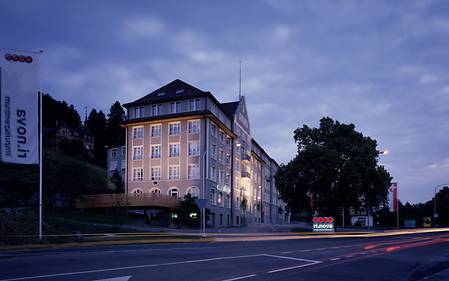Picosecond laser for carbides and ceramics
Laser factory uses state-of-the-art LASERTEC machines from DMG MORI in the manufacture of complex and filigree 3D moulds for tool and mould construction.
Established in 2002 in Rebstein, Switzerland, Laser factory GmbH has become firmly established in the area of precision laser removal within just a few years. The innovative service provider now manufactures complex and filigree 3D moulds for customers in the clock industry, the automotive industry and the tool and mould construction industry using injection moulding and stamping in two locations on a total of ten LASERTECH 40 Shape machines from DMG MORI. The laser sources that are available in manufacturing consist of lamp-pulsed and diode-pulsed lasers, fibre-guided lasers and picosecond lasers, meaning that an extremely wide range of materials can be economically machined, including carbides and ceramics.
With many years of experience in tool construction and cold forming, Björn Büchel and Michael Köppel recognised the potential of laser removal at an early stage. With the aid of modern laser technology, the Laser factory founders were in a position to manufacture sophisticated 3D moulds economically and with high precision, even in small quantities. "In those days we were one of the first companies on the market to manufacture in this way", recalls Michael Köppel. This gave the company a head start in knowledge that Laser factory is continuing to maintain. Björn Büchel adds: "As technology advances, our processes are also being continuously optimised, meaning that our performance spectrum is in a continuous state of development".
The special thing about the performance spectrum at Laser factory is the wide range of products. "Laser removal is mainly used for in-house manufacture in bigger companies, where the number of applications is usually limited", explains Björn Büchel. However, as a service provider you have to meet new challenges all of the time. He refers to the wide range of materials and complexity of the 3D moulds. "Because of the laser technology, we can work in an extremely economical and customer-oriented way".
The advantages of laser removal as compared to conventional manufacturing procedures such as vertical eroding are obvious: Even the most complex moulds are generated directly on the basis of 3D data, without having to carry out complicated and expensive electrode manufacture as an intermediate step. Laser factory is therefore already operating profitably from batch sizes of 1. The moulds are also easy to reproduce. "This means that throughput times and development times can be reduced considerably", says Michael Köppel. Many customers send in 3D data in the morning and pick up the finished mould in the evening.
Performance spectrum increased thanks to picosecond lasers
The further development of laser technology has led to a situation whereby Laser factory has been able to continuously increase the quality of its 3D moulds. Contours become finer, walls become steeper and the quality of surfaces improves. With the modern picosecond laser, even carbides and ceramics can be efficiently machined with maximum precision, unlike the situation in conventional manufacturing. Michael Köppel regards this as a major bonus for customers: "Carbide tools have a significantly longer service life during stamping and embossing". The surface quality of Ra 0.15 to 0.20 is also so high that the amount of polishing can be minimised by up to 70 percent.
Laser factory has been using the picosecond laser since 2012. Björn Büchel reflects: "The innovative laser source has opened up new possibilities to us, but also gave us some major challenges in the beginning". Suddenly, additional parameters had to be taken into consideration in the manufacturing process. Because as well as current intensity, frequency, speed, tracking offset and layer removal, in this case the focus also has to be adjusted by means of a height adjustment in order to monitor the high intensity of the picosecond laser. In the beginning, it was also necessary to suppress the initial pulse in order to avoid removing too much material. "You are treading a fine line when the amount that you are removing is just 1/10,000 mm", adds Michael Köppel.
Laser factory has long since overcome the initial challenges of the picosecond laser. "With the aid of LASERSOFT 3D we can work extremely comfortably and achieve optimum manufacturing results", says Björn Büchel about the software developed by DMG MORI. This also applies to the control of the laser. "Thanks to 6-axis technology, vertical walls can also be created using the LASERTEC 40 Shape". Overall, Michael Köppel regards the use of the picosecond laser as a major step in the development of the business: "We have managed to win back many customers, because carbide machining using laser removal has considerable advantages".
As in previous years, Laser factory will continue to grow together with the laser technology, and meet new challenges. The two managing directors would also like to extend the performance spectrum, if technical progress permits it. For example, Björn Büchel and Michael Köppel are pinning their hopes on laser structuring, which DMG MORI already uses successfully on larger machines: "Even if the technology works on a small scale, it could result in more applications that are interesting to us".



